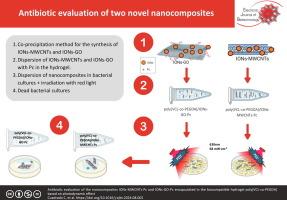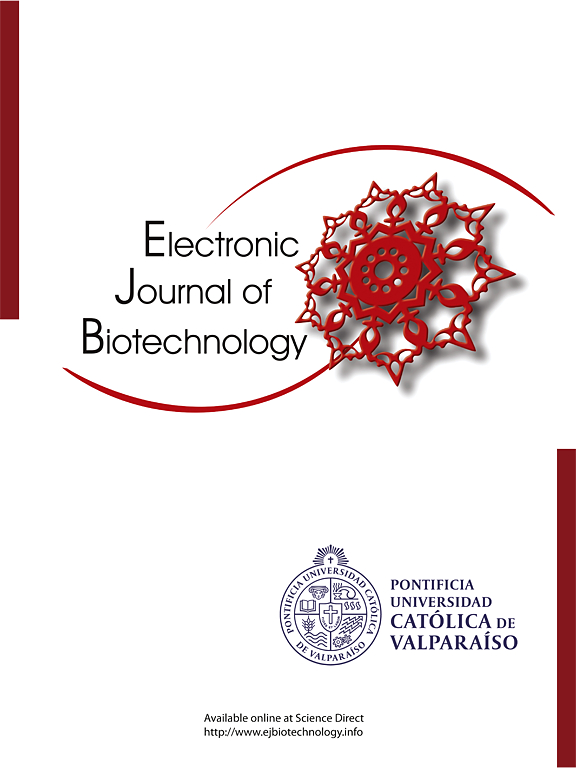基于光动力效应的包裹在生物相容性水凝胶聚(VCL-co-PEGDA)中的纳米复合材料 IONs-MWCNTs-Pc 和 IONs-GO-Pc 的抗生素评价
IF 2.5
4区 生物学
Q3 BIOTECHNOLOGY & APPLIED MICROBIOLOGY
引用次数: 0
摘要
背景抗药性细菌(包括金黄色葡萄球菌和大肠杆菌)的增加给医疗保健带来了巨大挑战。本研究的重点是开发两种新型纳米复合材料:包裹在生物相容性聚(VCL-co-PEGDA)水凝胶中的 IONs-MWCNTs-Pc 和 IONs-GO-PC。结果合成的纳米复合材料在 630 纳米红光照射下显示出显著的抗菌活性,明显降低了金黄色葡萄球菌 ATCC 27543、金黄色葡萄球菌 ATCC 33591 和大肠杆菌 ATCC 971182 的存活率。光动力研究表明,与 IONs-MWCNTs-Pc 相比,IONs-GO-PC 纳米复合材料生成单线态氧的效率更高,这与其卓越的抗菌性能有关。该研究表明,IONs-MWCNTs-PC 和 IONs-GO-Pc 纳米复合材料有望成为抗生素耐药细菌引起的感染的替代疗法,其中基于 GO 的复合材料显示出更高的光动力疗法疗效。这些研究结果表明,此类纳米复合材料可在推进抗菌策略以对抗耐药病原体方面发挥关键作用:Cuadrado C, Mantilla A, Hidalgo L, et al.基于光动力效应对包裹在生物相容性水凝胶聚(VCL-co-PEGDA)中的纳米复合材料 IONs-MWCNTs-Pc 和 IONs-GO-Pc 的抗生素评估。https://doi.org/10.1016/j.ejbt.2024.08.002.本文章由计算机程序翻译,如有差异,请以英文原文为准。

Antibiotic evaluation of the nanocomposites IONs-MWCNTs-Pc and IONs-GO-Pc encapsulated in the biocompatible hydrogel poly(VCL-co-PEGDA) based on photodynamic effect
Background
The rise of drug-resistant bacteria, including Staphylococcus aureus and Escherichia coli, presents a significant healthcare challenge. This study focuses on the development of two novel nanocomposites IONs-MWCNTs-Pc and IONs-GO-Pc encapsulated within a biocompatible poly(VCL-co-PEGDA) hydrogel. These composites are designed for use in photodynamic therapy and evaluated for their antimicrobial efficacy against resistant pathogens.
Results
The synthesized nanocomposites, when irradiated with red light at 630 nm, showed significant antimicrobial activity, resulting in a marked reduction in the viability of S. aureus ATCC 27543, S. aureus ATCC 33591, and E. coli ATCC 971182. Photodynamic studies demonstrated that the IONs-GO-Pc nanocomposite was more efficient in generating singlet oxygen compared to IONs-MWCNTs-Pc, which correlated with its superior antimicrobial performance. Structural and chemical characterization confirmed the successful incorporation of nanomaterials and photosensitizers, enhancing the photodynamic effect.
Conclusions
The study demonstrates that both IONs-MWCNTs-Pc and IONs-GO-Pc nanocomposites show promise as alternative treatments for infections caused by antibiotic-resistant bacteria, with the GO-based composite showing higher photodynamic therapy efficacy. These findings suggest that such nanocomposites could play a pivotal role in advancing antimicrobial strategies against resistant pathogens.
How to cite: Cuadrado C, Mantilla A, Hidalgo L, et al. Antibiotic evaluation of the nanocomposites IONs-MWCNTs-Pc and IONs-GO-Pc encapsulated in the biocompatible hydrogel poly(VCL-co-PEGDA) based on photodynamic effect. Electron J Biotechnol 2025;73. https://doi.org/10.1016/j.ejbt.2024.08.002.
求助全文
通过发布文献求助,成功后即可免费获取论文全文。
去求助
来源期刊

Electronic Journal of Biotechnology
工程技术-生物工程与应用微生物
CiteScore
5.60
自引率
0.00%
发文量
50
审稿时长
2 months
期刊介绍:
Electronic Journal of Biotechnology is an international scientific electronic journal, which publishes papers from all areas related to Biotechnology. It covers from molecular biology and the chemistry of biological processes to aquatic and earth environmental aspects, computational applications, policy and ethical issues directly related to Biotechnology.
The journal provides an effective way to publish research and review articles and short communications, video material, animation sequences and 3D are also accepted to support and enhance articles. The articles will be examined by a scientific committee and anonymous evaluators and published every two months in HTML and PDF formats (January 15th , March 15th, May 15th, July 15th, September 15th, November 15th).
The following areas are covered in the Journal:
• Animal Biotechnology
• Biofilms
• Bioinformatics
• Biomedicine
• Biopolicies of International Cooperation
• Biosafety
• Biotechnology Industry
• Biotechnology of Human Disorders
• Chemical Engineering
• Environmental Biotechnology
• Food Biotechnology
• Marine Biotechnology
• Microbial Biotechnology
• Molecular Biology and Genetics
•Nanobiotechnology
• Omics
• Plant Biotechnology
• Process Biotechnology
• Process Chemistry and Technology
• Tissue Engineering
 求助内容:
求助内容: 应助结果提醒方式:
应助结果提醒方式:


